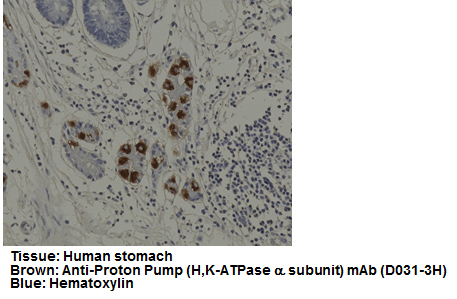Anti-Proton Pump (H,K-ATPase alpha subunit) (Mouse) mAb
| Code | Size | Price |
|---|
| MBL-D031-3H | 6 mL | £230.00 |
Quantity:
Prices exclude any Taxes / VAT
Overview
Antibody Isotype: IgG1
Antibody Clonality: Monoclonal
Antibody Clone: 1H9
Regulatory Status: RUO
Target Species:
- Bovine (Cattle)
- Human
- Mouse
- Rat
Application: Immunohistochemistry (IHC)
Shipping:
4°C
Storage:
4°C
Images
Documents
Further Information
Background:
Hydrogen-potassium adenosine
triphosphatase (H
+
, K
+
-ATPase) belongs to a family of
P-type cation-transporting ATPases that also includes
Ca
2+
-ATPase and Na
+
, K
+
-ATPase. H
+
, K
+
-ATPase is
responsible for acid secre
tion into the stomach and
catalyzes electroneutral excha
nge of cytoplasmic hydrogen
ions and external potassium ions coupled with ATP
hydrolysis. The enzyme is found in gastric parietal cells
where it is located in cytoplasmi
c vesicles or apical plasma
membranes of the secretory canaliculus. H
+
, K
+
-ATPase is
a heterodimer consisting of a high molecular weight
catalytic
α
subunit and a smaller but heavily glycosylated
α
subunit. The
α
subunit of H
+
, K
+
-ATPase has 10
transmembrane domains and
contains sites for ATP
binding and its acylphosphorylation, binding sites of
proton pump inhibitors, and sites responsible for ion
recognition.
Formulation:
Prepared from culture supernatant with preservative (0.09% sodium azide)
Gene IDs:
Human: 495 Mouse: 11944 Rat: 24216
Immunogen Translated:
This product is an antibody obtained from a hybridoma by fusing mouse myeloma cells and spleen cells BALB / c nu / + mouse neonatal thymectomy anti-gastric wall cells to produce antibodies.
Reactivity:
This antibody reacts with human,
mouse, rat and bovine H
+
, K
+
-ATPase
α
subunit.
Shelf Life:
3 years
Source:
This product is hybridoma (clone 1H9) supernatant. This hybridoma (clone 1H9) was
established by fusion of mouse myeloma cell Sp2/0-Ag14
with Balb/c nu/+ mouse splenocyte with neonatal
thymectomy-induced autoimmune gastritis.
Target:
Proton pump
References
1) Katakai, T.,
et al
.,
J
.
Immunol
.
177
, 7858-7867 (2006)
2) Kawamura, Y. I.,
et al
.,
Cancer
Res
.
65
, 6220-6227 (2005)
3) Murphy, K.,
et al
.,
Int
.
Immunol
.
15
, 269-277 (2003)
4) Laurie, K. L.,
et al
.,
J
.
Immunol
.
169
, 2361-2367 (2002)
5) Kimura, T.,
et al
.,
J
.
Biochem
.
131
, 923-932 (2002)
6) Kimura, T.,
et al
.,
J
.
Biol. Chem
.
277
, 20671-20677 (2002)
7) Biondo, M.,
et al
.,
J
.
Immunol
.
166
, 2090-2099 (2001)
8) Alderuccio, F.,
et al
.,
Int
.
Immunol
.
12
, 343-352 (2000)
9) Jones, C. M.,
et al
.,
Gastroenterology
101
, 287-294 (1991)
10) Toh, B.,
et al
.,
PNAS
87
, 6418-6422 (1990)
11) Mori, Y.,
et al., Gastroenterology
97
, 364-375 (1989)
Clone 1H9 is used in these references.



